Alternanthera Lilacina, also known as the Purple Joy, is a captivating aquatic plant that adds a touch of mystery and vibrancy to any aquascape. Its beautiful purple leaves and lush growth have become a popular choice among aquarists.
In this comprehensive guide, I will delve into the various aspects of Alternanthera Lilacina cultivation, including its origins, care essentials, ideal tank environment, planting and arrangement tips, growth and development cycles, propagation techniques, maintenance and pruning practices, exploring different varieties, and personal observations from a real-life aquascape.
Whether you’re a beginner or an experienced aquarist, this article will provide valuable insights and practical advice to ensure the successful cultivation of Alternanthera Lilacina in your aquarium.
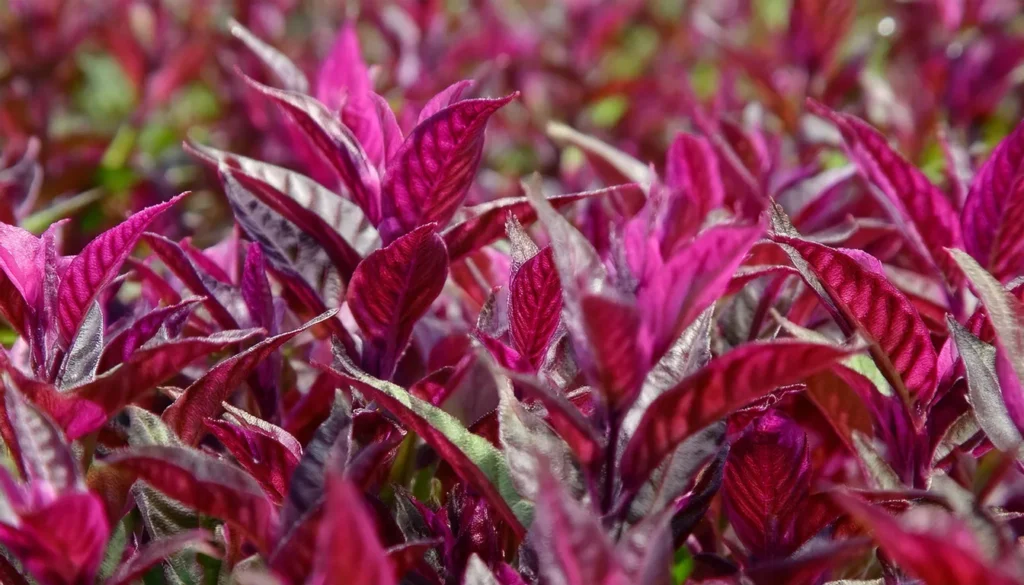
Key Takeaway
- Alternanthera Lilacina, or the Purple Joy, is a captivating aquatic plant with vibrant purple leaves.
- Proper care and maintenance are essential for cultivating Alternanthera Lilacina in an aquarium.
- Lighting, water parameters, substrate choice, and nutrient supplementation are key for optimal growth.
- Alternanthera Lilacina can be propagated through stem cuttings or side shoots, allowing it to expand its population in the tank.
- Regular pruning and maintenance practices and observation of growth patterns are crucial for the plant’s health and appearance.
Quick Stats
| Attribute | Details |
| Family Name | Amaranthaceae |
| Origin | South America |
| Height | 6-12 inches (15-30 cm) |
| pH Range | 6.0-7.5 |
| CO2 Requirement | Low to Medium |
| Growth Rate | Moderate to Fast |
| Care Level | Moderate |
| Color Form | Purple foliage with green undersides |
| Water Conditions | Keep soil evenly moist |
| Max Size | Up to 12 inches (30 ……cm) in height |
| Lighting | Medium to high, prefers bright light |
| Supplements | Balanced liquid fertilizer occasionally |
| Placement | Foreground to midground in aquariums |
| Propagation | Stem cuttings |
What Is Alternanthera Lilacina?
Alternanthera Lilacina is a species native to South America, particularly Brazil, where it thrives in the tropical climate. Belonging to the Amaranthaceae family, it is closely related to other popular aquatic plants like Alternanthera reineckii and Alternanthera reineckii ‘Mini.’
The plant is characterized by its striking purple leaves, which provide a unique and eye-catching contrast in aquascapes. With a moderate growth rate, Alternanthera Lilacina can reach a height of 6-8 inches under optimal conditions.
Its growth pattern tends to be more compact and upright than other Alternanthera species, making it an ideal choice for aquascaping projects.
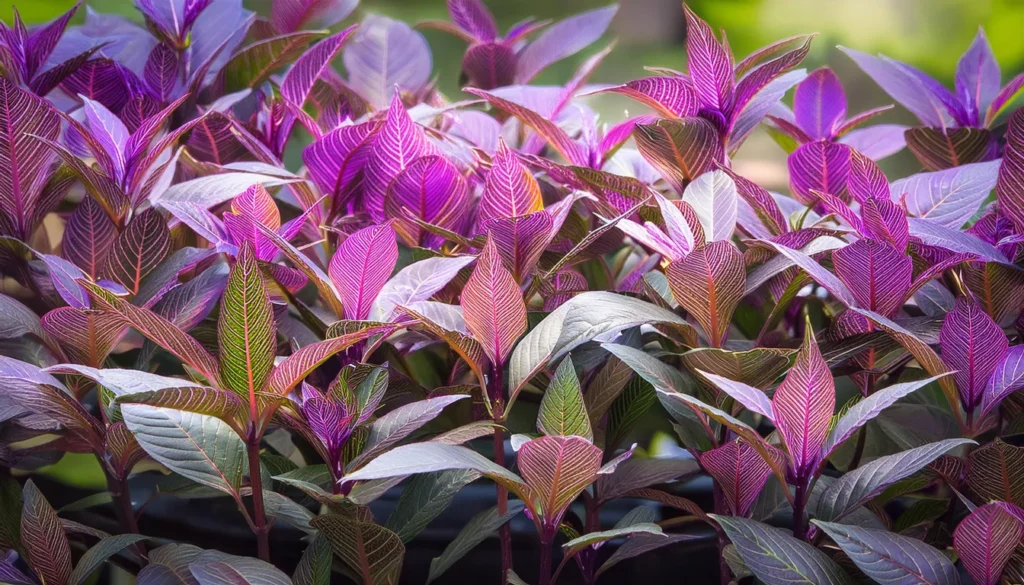
The vibrant coloration of Alternanthera Lilacina makes it a popular choice for aquascapes looking to add depth and visual interest to their tanks.
The deep purple leaves create a stunning contrast against green plants or a contrasting substrate, creating a visually appealing and dynamic aquascape.
The Appeal Of The Mysterious Purple Joy In Aquascaping
Alternanthera Lilacina’s unique coloration and growth habits make it an intriguing addition to any aquascape. The mysterious purple hue adds depth and richness to the overall design, creating a captivating visual focal point.
With its compact and upright growth, Alternanthera Lilacina can be strategically placed as a mid-ground or background plant, depending on its height and growth habit.
The plant’s lush foliage and vibrant purple leaves create a sense of lushness and vitality, enhancing the aesthetics of the aquarium.
Furthermore, its moderate growth rate allows for easy maintenance and control in the aquascape, making it a suitable choice for aquarists of all skill levels.
Whether you are a beginner or an experienced hobbyist, Alternanthera Lilacina offers a versatile and attractive aquatic plant option for creating stunning underwater landscapes.
Lighting Requirements For Optimal Growth
- Alternanthera Lilacina requires moderate to high lighting to support its photosynthesis process and promote healthy growth. Insufficient lighting can result in elongated stems and pale leaves, compromising the plant’s overall appearance.
- To ensure optimal growth, provide your Alternanthera Lilacina with adequate lighting that replicates its natural habitat.
Nutrient And CO2 Needs For Vibrant Coloration
- In addition to proper lighting, Alternanthera Lilacina benefits from a nutrient-rich environment. A balanced nutrient regimen, including essential micronutrients and macronutrients like nitrogen (N), phosphorus (P), and potassium (K), is necessary for healthy growth and vibrant coloration.
- Regular water testing and adjustment of nutrient levels will ensure that the plant receives the necessary nutrition.
- Supplementing your tank with CO2 can greatly enhance the growth and coloration of Alternanthera lilacina. CO2 aids in the uptake of nutrients and promotes vibrant colors.
- Maintaining a stable CO2 level of around 20-30 ppm is optimal for the growth and color development of Alternanthera lilacina. Monitoring and adjusting CO2 levels will help maintain the plant’s vibrant appearance.
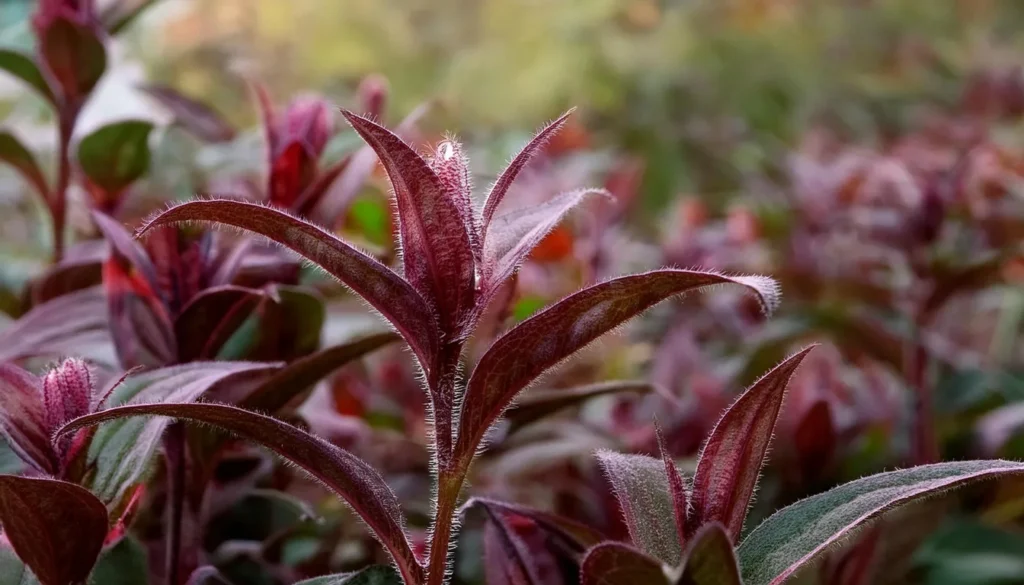
| Care Essentials | Requirements |
| Lighting | Moderate to high lighting levels |
| Nutrients | Balance of micronutrients and macronutrients (N, P, K) |
| CO2 | Stable CO2 level of 20-30 ppm |
Substrate Considerations
- Choosing the right substrate is crucial for supporting the root system and nutrient uptake of Alternanthera lilacina. A nutrient-rich substrate, such as aqua soil or a combination of nutrient-rich substrates topped with sand, is recommended. These substrates provide the necessary nutrients and support stable moisture levels for the plant’s roots.
Water Parameters
- Proper water parameters are essential for the optimal growth and development of Alternanthera lilacina. The plant thrives in slightly acidic to neutral conditions, with a pH range of 6.0-7.0. The water hardness should ideally be maintained in the 3-7 dKH range. Maintaining a stable temperature between 72-82°F (22-28°C) is also ideal for the plant’s overall health.

Tips
- Caring for Alternanthera Lilacina’s delicate roots is crucial to ensuring successful growth. Before planting, gently rinse the plant’s roots to remove any debris or excess substrate. This helps maintain a clean and healthy planting environment.
- After preparing the roots, create a small hole in the aquarium’s substrate. Carefully place the Alternanthera Lilacina plant into the hole, ensuring the substrate fully covers the roots. This provides the plant with a stable foundation for growth.
- Lightly press down on the substrate around the plant to secure it. This helps to prevent the plant from becoming dislodged or uprooted.
- Consider its height and growth habit when arranging Alternanthera Lilacina in your aquascape. As a mid-ground or background plant, Alternanthera Lilacina can add depth and visual interest to your aquarium. Experiment with different placement options to achieve a balanced and aesthetically pleasing composition.
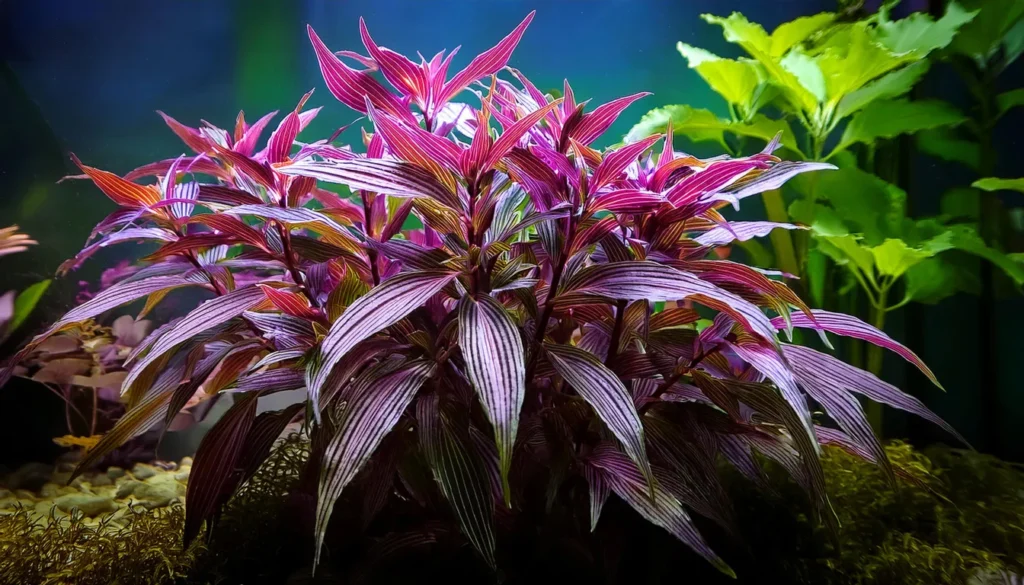
Growth Cycle
- After planting Alternanthera Lilacina, it goes through an initial acclimation period. During this time, some leaf melting or shedding may occur as the plant adapts to its new environment. This natural process is nothing to be concerned about.
- As the plant settles, new growth will emerge, revealing the full vibrancy of the purple leaves. Close monitoring is needed during this phase to ensure the plant’s health and development.
- Pay attention to the growth patterns and color changes in the leaves. These visual cues can provide valuable insights into the plant’s overall well-being. Consistent leaf coloration, vigorous roots, and increased size characterize healthy growth.
RELATED: Alternanthera Rosaefolia: A Pink Paradise In Your Aquarium
Observing Changes And Adjusting Care Regimen
Regular observation is key to understanding the specific needs of Alternanthera Lilacina during different stages of its growth cycle.
By closely monitoring the plant’s response to its environment, adjustments can be made to its care regimen to ensure optimal growth and vibrant coloration.
Some key care adjustments that may be required include:
- Lighting: Adequate lighting is crucial for Alternanthera lilacina’s photosynthesis process and healthy growth. Adjust the intensity and duration of light exposure based on the plant’s response.
- CO2 Supplementation: To enhance growth and color development, consider supplementing the tank with CO2. Maintaining a stable CO2 level within the recommended range promotes vibrant colors and robust growth.
- Nutrient Dosing: Evaluate the nutrient levels in the tank and make necessary adjustments to provide a balanced diet for Alternanthera lilacina. Ensure the plant receives essential micronutrients and macronutrients for healthy development.

Propagation Techniques
Propagation is an essential skill for expanding your Alternanthera Lilacina population and maintaining the beauty of this captivating aquatic plant. There are two main techniques for propagating Alternanthera Lilacina: stem cuttings and side shoots.
- Stem Cuttings
To propagate through stem cuttings, select a healthy and well-established stem. Cut the stem just below a node using clean scissors or pruning shears, ensuring that you have at least two nodes on the cutting. This will provide enough tissue for new roots to develop.
Plant the stem cutting in a separate location or the same tank with appropriate substrate conditions and care, providing the same requirements as the parent plant. Place the cutting in the substrate, ensuring at least one node is buried. Maintain proper lighting, CO2 supplementation, and nutrient levels to support the cutting’s growth and development.
- Side Shoots
Another method of propagation is to encourage the growth of side shoots. By cutting back the main stem, you can stimulate the emergence of new shoots from the trimmed area. These side shoots can be separated and planted as plants, establishing new individuals within your aquascape.
Ensure proper maintenance, including regular pruning and care adjustments, to promote the healthy growth and expansion of your Alternanthera Lilacina population in the aquarium. By mastering these propagation techniques, you can enjoy the beauty of this aquatic plant while creating a lush and vibrant aquascape.
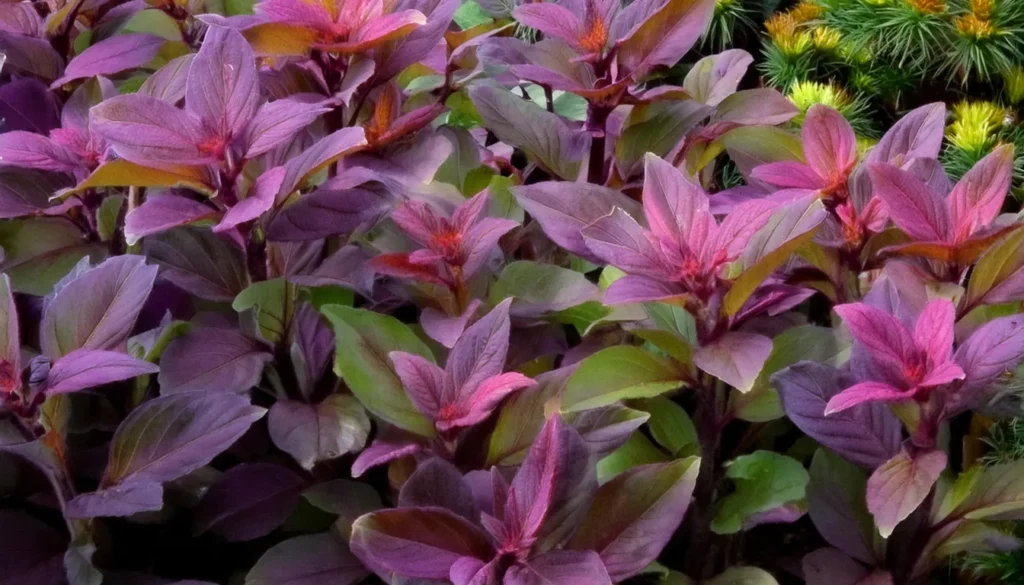
Pruning For Healthier Plants
- Pruning Alternanthera Lilacina should be done when the plant is actively growing, typically every 4-6 weeks. This timing allows for new growth to emerge and prevents stunting.
- To prune Alternanthera Lilacina, use clean scissors or pruning shears to make precise cuts just above a node, ensuring a clean and smooth cut. Cutting above a node encourages new growth and prevents the stem from dying.
Dealing With Common Issues During Pruning
- During pruning, Alternanthera Lilacina commonly releases plant sap, which can temporarily cloud the water. This cloudiness is normal and will subside after a few hours. However, if the cloudiness persists or worsens, it may indicate an underlying issue, such as poor water quality or nutrient deficiencies.
- Proper lighting and nutrient levels are important to address common issues during pruning. Ensure that pruned areas receive adequate light and nutrient supply to facilitate healthy regrowth.
- Monitor the plant for signs of nutrient deficiencies, such as pale or yellowing leaves, and address them promptly by adjusting your fertilization regimen. Additionally, be vigilant for any signs of algae growth or potential pest infestations, as they can adversely affect the plant’s health.
RELATED: Alternanthera Bettzickiana Green Planting Detailed Guide
Varieties
- Alternanthera Lilacina offers several varieties with unique visual differences and growth patterns.
- Varieties may differ in leaf shape, size, intensity of purple coloration, and overall growth habits.
- Some varieties may exhibit more compact growth, while others may grow taller and spread more extensively.
- Care requirements may vary slightly among different Alternanthera Lilacina varieties, so it is important to research and understand each’s specific needs before making a selection.
- When choosing the right variety of Alternanthera Lilacina for your aquarium, consider factors such as tank size, lighting intensity, and overall aquascape design.
| Variety | Leaf Shape | Leaf Size | Purple Coloration | Growth Habit |
| Variety 1 | Oval | Small | Moderate | Compact |
| Variety 2 | Round | Medium | Intense | Tall and spreading |
| Variety 3 | Lanceolate | Large | Subdued | Compact and bushy |
Observations From A Real-Life Aquascape With Alternanthera Lilacina
- While cultivating Alternanthera Lilacina in my aquascape, I have been captivated by its stunning beauty and unique growth patterns. The vibrant purple leaves add a touch of elegance and mystery to the underwater landscape, creating a visually appealing focal point.
- Under moderate to high lighting and CO2 supplementation conditions, I observed the Alternanthera Lilacina thrive and develop lush growth. The leaves took on a deep and rich purple hue, providing a striking contrast against the surrounding green plants and substrate.
- I noticed that Alternanthera Lilacina tends to adopt a more compact and upright growth habit compared to other Alternanthera species. This made it an ideal choice as a mid-ground or background plant in my aquascape, contributing to a sense of depth and visual interest.
- Regular pruning was crucial to maintain the health and vibrancy of Alternanthera lilacina. By trimming back excessive or overgrown stems, I promoted healthy regrowth and prevented the plant from becoming overcrowded. The pruning process was straightforward, and the plant quickly recovered, showcasing new growth and maintaining its overall appearance.

Cultivation Challenges And Triumphs
- Although Alternanthera Lilacina is a stunning aquatic plant, it did present some cultivation challenges that required careful attention and adjustment.
- One particular challenge I faced was maintaining the perfect lighting balance and CO2 supplementation. Finding the optimal lighting intensity and CO2 levels proved crucial in achieving vibrant coloration and healthy growth. I had to experiment with different settings and monitor the plant’s response to ensure it received the right amount of light and carbon dioxide.
- Another challenge was managing Alternanthera lilacina’s growth rate. As a fast-growing plant, it required regular pruning to prevent it from overshadowing other plants in the aquascape. By monitoring its growth and trimming excess stems, I could maintain a harmonious balance in the tank.
- Despite these challenges, the triumphs of cultivating Alternanthera Lilacina far outweighed the difficulties. The plant’s beauty and vibrancy brought immense joy and satisfaction to my aquascape, creating a captivating underwater haven.
| Growth Observations | Cultivation Challenges |
| Stunning vibrant purple leaves | Managing lighting and CO2 levels |
| Compact and upright growth habit | Controlling growth rate through pruning |
| Significant visual contrast in aquascape |
Conclusion
Cultivating Alternanthera Lilacina can be a rewarding and visually stunning experience for aquarists. This captivating aquatic plant brings vibrant purple hues to any aquascape, adding a touch of mystery and beauty.
Alternanthera Lilacina can thrive and become a stunning centerpiece in your aquarium by providing the right care and environment.
Key considerations for successful Alternanthera Lilacina cultivation include appropriate lighting to support its photosynthesis and vibrant coloration.
Maintaining optimal water parameters, such as slightly acidic to neutral conditions and stable temperature, is also crucial for its growth and overall health.
Additionally, incorporating CO2 supplementation and ensuring a nutrient-rich substrate will promote healthy growth and vibrant foliage.
Frequently Asked Questions
How Can I Optimize Alternanthera Lilacina’s Color Intensity And Growth In A High-Tech Planted Tank?
To optimize the color and growth of Alternanthera lilacina in a high-tech setup, ensure you provide high-intensity lighting, CO2 supplementation at 20-30 ppm, and a well-balanced fertilization regimen that includes both macro (N-P-K) and micro (Fe and other trace elements) nutrients.
High lighting encourages the plant to produce more anthocyanins, which contribute to its vibrant coloration. Regular pruning not only maintains the desired shape and size but also encourages bushier growth by stimulating new shoots.
What Specific Micronutrient Deficiencies Affect Alternanthera Lilacina The Most, And How Can They Be Identified?
Alternanthera lilacina is particularly sensitive to iron deficiency, which is essential for chlorophyll production and overall health.
Iron deficiency manifests as pale, yellowish, or white new growth, while older leaves may retain their color. Regularly dosing a chelated iron supplement can prevent these symptoms.
Additionally, keep an eye out for signs of potassium deficiency, such as pinholes in the leaves or edge browning, which can be corrected with targeted potassium supplementation.
Can Alternanthera Lilacina Adapt To Non-Co2, Low-Tech Environments, And What Are The Trade-Offs?
While Alternanthera lilacina can survive in non-CO2, low-tech setups, its growth will be slower, and its vibrant colors may become less pronounced, often resulting in a more greenish hue.
To help it adapt to such environments, ensure you provide ample lighting and nutrient-rich substrate or regular root tab fertilization. Be mindful that without CO2 supplementation, achieving the intense colors seen in high-tech tanks may be challenging.
How Do I Effectively Propagate Alternanthera Lilacina To Maintain Its Dense, Bushy Appearance?
Propagate Alternanthera lilacina by stem cuttings. Choose healthy, robust stems and cut just above a leaf node. Remove the lower leaves and plant the cutting into the substrate, ensuring good contact.
The cutting will develop roots and new growth from the node, while the original stem will produce new lateral shoots, contributing to a fuller appearance. Regular trimming encourages the plant to branch out, enhancing its bushy form.
What Advanced Techniques Can Be Used To Combat Algae Growth On Alternanthera Lilacina Without Harming The Plant?
Managing algae on Alternanthera lilacina involves optimizing tank conditions to discourage algae without negatively impacting the plant.
Ensure balanced lighting (avoid excessive intensity or duration), and maintain CO2 and nutrient levels to support plant health over algae growth. Introducing algae-eating fish or invertebrates can help control algae physically.
For stubborn algae, spot treatments with diluted hydrogen peroxide or manual removal during water changes can be effective, taking care to minimize stress on the plants.
- Unveiling The Wonders Of Riccia Fluitans In Aquascapes - August 7, 2024
- Vallisneria Gigantea Var. Guide To Care And Cultivation At Home - July 31, 2024
- Vesicularia Dubyana Care & Growth Guide Tips For Beginner Gardeners - July 30, 2024
